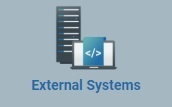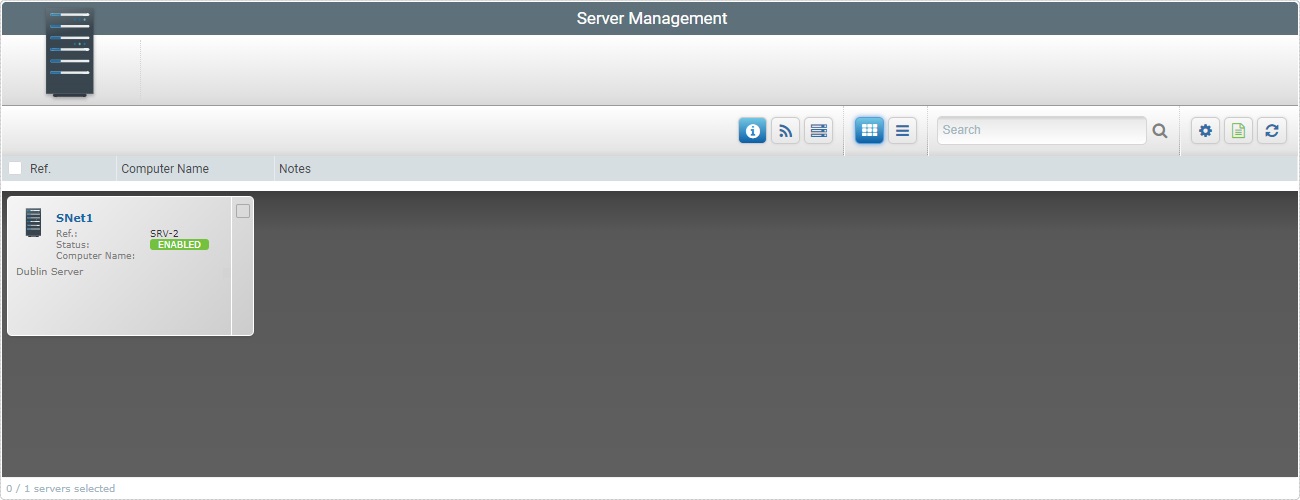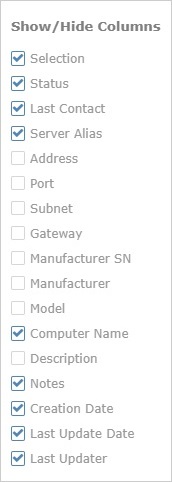Servers
Overview
A server is an entity that represents the application installed on a back-end host server (to which the device will send and receive business data).
Refer to the MCL-Net V4 User Guide for more detailed information on MCL Net subscription activation steps.
To access the "Server Management" page, click  (in the "Control Panel" section) and, in the resulting row below, select
(in the "Control Panel" section) and, in the resulting row below, select  .
.

The image below illustrates the page that is accessed when clicking  .
.
The "Servers" page displays all the servers available within the current site.
This information can be displayed in a grid or a list view. By default, servers are displayed in a grid view but the view can be changed. Sometimes, depending on the selected view, you may have access to different information.
Icon |
Description |
|---|---|
Server Statuses |
|
|
Server status “Enabled” - the server is active. |
|
Server status “Disabled” - the server is inactive but it will still communicate with the account to check for status changes. It simply will not perform any tasks. |
Last Contact Statuses |
|
|
The last time the server sent information. Mouse over the icon to see last contact date and time. |
|
No server contact or no contact in the previous hour. |
Click ![]() or
or ![]() to select the most appropriate view:
to select the most appropriate view:
•Click ![]() for a grid view:
for a grid view:

This view displays the following information:
(In light blue) |
The server's alias or name. Click it to access the "Server Details" page. See Server Details. |
Status |
The server's status ("Enabled" or "Disabled"). |
Computer Name |
The back end host server's name/alias. |
Notes |
Information regarding the server, added in the server's own details page. |
•Click ![]() for a list view:
for a list view:

This view displays the following information:
Status columns |
The initial columns display status icons regarding the device's current status. |
Server Alias |
The server's alias or name. Click it to access the "Server Details" page. See Server Details. |
Computer Name |
The back end host server 's name. |
Notes |
Information you added in the corresponding "Server Details" page (in the "Notes" field). |
Creation Date |
When the server was created. |
Last Update Date |
The server's last update date. |
Last Updater |
The name of the user that last updated the server's info. |
There are several views available, each one with its own specific information - "Properties", "Network", and "Server Details".
Click the intended icon to have the corresponding view displayed.
Below is a description of each view/presented information:
|
|
|
|
This view displays the following information:
Status columns |
The initial columns display status icons regarding the device's current status. |
(In light blue) |
The server's alias or name. Click it to access the "Server Details" page. See Server Details. |
Server Alias |
The server's alias or name. Click it to access the "Server Details" page. See Server Details. |
Status |
The server's status ("Enabled" or "Disabled"). |
Computer Name |
The back end host server 's name. |
Computer Name |
The back end host server's name/alias. |
Notes |
Information you added in the corresponding "Server Details" page (in the "Notes" field). |
Notes |
Information you added in the corresponding "Server Details" page (in the "Notes" field). |
Creation Date |
When the server was created. |
|
|
Last Update Date |
The server's last update date. |
|
|
Last Updater |
The name of the user that last updated the server's info. |
|
|
|
|
|
|
This view displays the following information:
Status columns |
The initial columns display status icons regarding the server's current status. |
Server Alias |
The server's alias or name. Click it to access the "Server Details" page. See Server Details. |
Server Alias |
The server's alias or name. Click it to access the "Server Details" page. See Server Details. |
Status |
The server's status ("Enabled" or "Disabled"). |
Address |
The server's address (if it is an MCL-Net server, enter "http:// + IP number"). |
Port |
The server's port. |
Port |
The server's port. |
Subnet |
The server's subnet mask. |
Subnet |
The server's subnet mask. |
Gateway |
The server's gateway. |
Gateway |
The server's gateway. |
Notes |
Information you added in the corresponding "Server Details" page (in the "Notes" field). |
Notes |
Information you added in the corresponding "Server Details" page (in the "Notes" field). |
|
|
|
|
|
|
This view displays the following information:
Status columns |
The initial columns display status icons regarding the server's current status. |
Server Alias |
The server's alias or name. Click it to access the "Server Details" page. See Server Details. |
Server Alias |
The server's alias or name. Click it to access the "Server Details" page. See Server Details. |
Status |
The server's status ("Enabled" or "Disabled"). |
Manufacturer SN |
The manufacturer serial number of the back end host server. |
Manufacturer SN |
The manufacturer serial number of the back end host server. |
Manufacturer |
The back end host server 's manufacturer. |
Manufacturer |
The back end host server 's manufacturer. |
Model |
The back end host server 's model. |
Model |
The back end host server 's model. |
Computer Name |
The back end host server 's name. |
Computer Name |
The back end host server 's name. |
Description |
The description of the Host provided by the host's operating system. |
Description |
The description of the Host provided by the host's operating system. |
The "Servers" page also offers the following options:

•![]() Use the search box to look for specific list items.
Use the search box to look for specific list items.
a. Enter what you want to search for.
b. Click ![]() or press <ENTER> in your PC keyboard to initiate the search.
or press <ENTER> in your PC keyboard to initiate the search.
c. To conclude the search operation, empty the search box by clicking ![]() and click
and click ![]() or press <ENTER> in your PC keyboard.
or press <ENTER> in your PC keyboard.
•![]() Use this button to Show/Hide columns in the navigation bar. Proceed as follows:
Use this button to Show/Hide columns in the navigation bar. Proceed as follows:
a. Click ![]() to access the Show/Hide Columns drop-down.
to access the Show/Hide Columns drop-down.

b. Select the column(s) to be shown/hidden by clicking the corresponding ![]() .
.
c. The changes are immediately applied in the view.
•![]() Use this button to export a list with the displayed servers. The "Servers" list is exported with an Excel file format.
Use this button to export a list with the displayed servers. The "Servers" list is exported with an Excel file format.
The conclusion of the export operation depends on the web browser used. You should be able to save the Excel file in your PC or open it directly after the download.
![]() Since the export only includes the currently displayed information, make sure the page is displaying the intended servers before you begin the export.
Since the export only includes the currently displayed information, make sure the page is displaying the intended servers before you begin the export.
To select the most appropriate view, use the ![]() filters.
filters.
•![]() Click this button to refresh the page's information.
Click this button to refresh the page's information.
•![]() Use the buttons, included in this bar, to organize the listed items of the corresponding column:
Use the buttons, included in this bar, to organize the listed items of the corresponding column:
▪![]() by ascending order.
by ascending order.
▪![]() by descending order.
by descending order.
▪![]() Click this button to select all the listed items. In this case, all the servers.
Click this button to select all the listed items. In this case, all the servers.
Click the server's alias (displayed in light blue) to access a page with the details of a particular server. See Server Details.
To delete a server, use the ![]() button. For more information, see Deleting a Server. This option is ONLY available, if a server is selected.
button. For more information, see Deleting a Server. This option is ONLY available, if a server is selected.
This chapter includes all the aspects associated to servers (server details, the adding and deleting of a server, etc.). The table below refers the user profiles that have access to the described operations:
![]()
Keep in mind that the account administrator and/or the site manager, at a lower level, can restrict other users' access rights. This user guide is presenting all the possibilities in terms of access.
Topic/Operation |
Description |
|---|---|
View the server's details. |
|
Edit the details of a server. |
|
Delete an unnecessary server. |